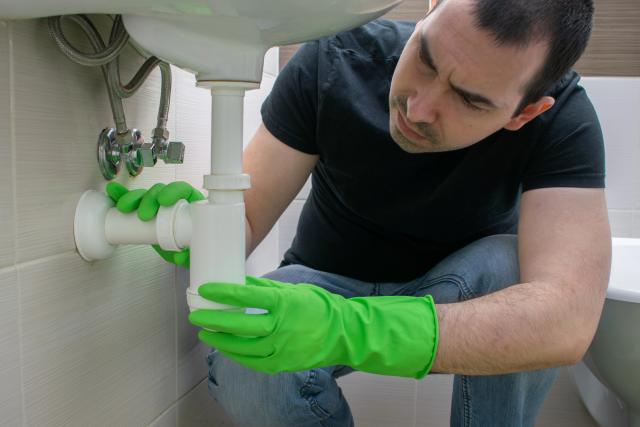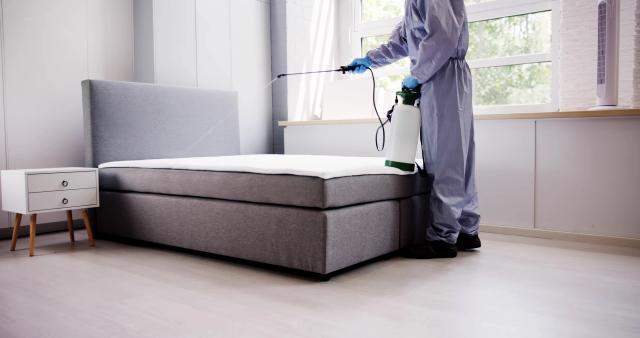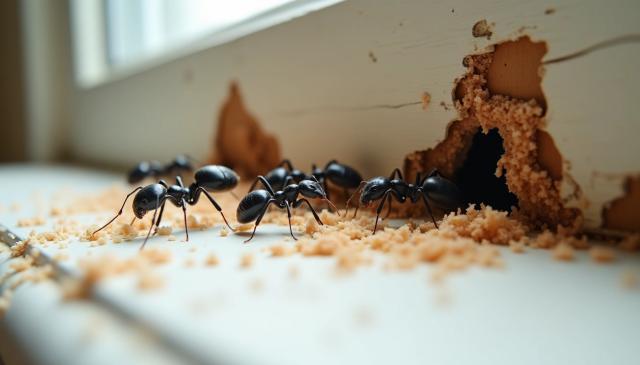
How to Repair a Bathroom Sink: Step-by-Step DIY Instructions
Bathroom sink problems can strike without warning, leaving you with annoying drips, slow drains,...

Bed bugs have made a significant comeback over the past decade, creating headaches for homeowners across urban areas who need effective elimination strategies. These stubborn pests continue expanding their reach throughout North America, Europe, Australia, and Asia, and they move faster than you might expect—covering up to four feet in under a minute. Treatment requires patience and persistence, often taking weeks to months, depending on how widespread your infestation has become. The good news is that you have options. Both DIY approaches and professional treatments can work when you apply them correctly. Research shows that traps alone detected 95% of infestations during building-wide bed bug inspections, and frequent washing combined with hot drying eliminates bed bugs hiding in fabrics. You can attempt do-it-yourself pest control, but hiring a professional often provides the best results, particularly since bed bugs have developed resistance to many common insecticides.
Catching a bed bug problem early makes all the difference in successful treatment. Finding an infestation before it becomes established saves you significant time, money, and frustration compared to battling a mature colony. Small infestations can be tricky to spot until they've already spread considerably.
Unexplained bite marks often provide the first hint of bed bugs, typically showing up on exposed areas like your face, neck, arms, and hands. These bites usually appear in clusters or lines rather than scattered individual marks. Not everyone reacts to bed bug bites, so physical evidence of the bugs themselves provides more reliable confirmation of an infestation.
Watch for these telltale signs:
|
Sign |
Description |
|---|---|
|
Blood stains |
Rusty or reddish spots on sheets and mattresses from crushed bugs |
|
Dark spots |
Black dots about the size of a period, which is bed bug excrement |
|
Eggs/shells |
Tiny (1mm) pale yellow eggs and shed skins from growing nymphs |
|
Live bugs |
Reddish-brown, oval-shaped insects about the size of an apple seed (5-7mm) |
|
Musty odor |
A sweet, musty smell produced through glands on the bugs' bodies |
Pro Tip: Use a flashlight and magnifying glass during inspections, particularly focusing on seams and crevices where bed bugs commonly hide.
Bed bugs got their name for good reason, but they don't restrict themselves to beds alone. 85% of bed bugs are found in or near sleeping areas, though they can establish themselves throughout your home. They start by clustering within 8 feet of where people sleep, then expand their territory as the population grows.
Common hiding places include:
These pests prefer fabric or wood surfaces over metal or plastic, making upholstered furniture prime real estate for infestations. Their flat bodies allow them to squeeze into incredibly tight spaces—even the head of a screw or inside electronics.
Bed bugs excel at hitchhiking, moving between locations by clinging to belongings and luggage. Most infestations begin when these pests are unknowingly transported into your home. A single fertile female can launch a full-scale infestation since she produces 200-500 eggs during her lifetime.
Infestations typically begin through:
Important note: Bed bugs don't discriminate between clean and dirty environments. Luxury hotels face the same risks as budget accommodations, and spotless homes can harbor infestations just as easily as cluttered ones.
You can tackle bed bugs yourself using several proven methods when you know the right techniques. These approaches work especially well for early-stage infestations, and each method targets different aspects of bed bug control—from removing hiding spots to directly killing the pests.
Your first step should be decluttering infested areas. Bed bugs thrive in cluttered spaces that offer countless hiding spots, so removing unnecessary items from bedrooms and living areas makes treatment more effective.
For items you need to keep:
Mark any discarded furniture with "Bed Bugs" using spray paint to warn others, and arrange for immediate waste collection pickup.
Mattress encasements trap bed bugs inside your mattress while preventing new ones from getting established. These specialized covers work in two ways: they starve existing bugs (which can take up to a year) and create a smooth, white surface that makes spotting new bugs much easier.
|
Feature |
Why It Matters |
|---|---|
|
Bite-proof fabric |
Prevents bugs from feeding through the material |
|
Complete coverage |
Must fully encase the mattress and box spring |
|
Tight-sealing zipper |
Small zipper teeth stop even tiny bugs from escaping |
|
End-stop zipper seal |
Eliminates gaps where bugs could get out |
Keep encasements in place for at least 12 months to ensure trapped bugs die from starvation.
Vacuuming removes significant numbers of bed bugs when you focus on the right areas. Target mattress seams, furniture crevices, baseboards, and carpet edges. Use a vacuum with a HEPA filter to prevent allergens from spreading through the air.
Steam cleaning kills bed bugs effectively since they die at temperatures above 118°F, and steam reaches 212°F. Apply steam steadily for 10-30 seconds per 12 inches of surface area. Use a steamer that maintains temperatures above 130°F and choose a wide nozzle rather than a pinpoint tip to avoid scattering bugs. Always steam before vacuuming since heat flushes bugs from their hiding spots.
Heat kills all bed bug life stages when applied correctly. Adult bugs die at 119°F, but their eggs need 125°F or higher. For clothing and bedding, wash in hot water followed by 30 minutes in a dryer on high heat. Small items can be treated with specialized heaters like PackTite® that maintain temperatures above 120°F for several hours.
Cold treatments require precise temperature control. Items must stay at 0°F for at least four days for complete elimination. Home freezers typically need 8 hours for 5 pounds of laundry to reach the necessary temperature.
Interceptor traps exploit bed bugs' inability to climb smooth surfaces. These simple devices detected 96% of infestations in one study, outperforming visual inspections by professionals. Place interceptors under furniture legs, especially around beds.
For thorough monitoring, use at least 12 interceptors in a typical two-bedroom apartment—four per bed and two per sofa or chair. Check weekly and clean monthly since dust buildup reduces their effectiveness.
Diatomaceous earth damages bed bugs' exoskeletons and causes dehydration. Apply it safely by wearing gloves and a face mask, then dust a thin layer along baseboards and around bed legs where bugs travel. Use a powder duster to get the material into cracks and crevices, and create rings around bed legs to force bugs to crawl through it.
Pro Tip: Only use food-grade diatomaceous earth. Pool-grade versions contain crystalline silica that can harm your lungs when inhaled. Clean and reapply weekly for up to four weeks for best results.
When dealing with bed bugs, knowing what doesn't work saves you valuable time and money. Many homeowners waste both on ineffective methods, allowing infestations to worsen while they struggle with solutions that simply don't deliver results.
Despite marketing promises, ultrasonic pest repellers provide zero protection against bed bugs. Northern Arizona University research conclusively showed these devices had absolutely no effect on bed bug behavior. Controlled experiments revealed bed bugs showed no preference between areas with or without active ultrasonic devices.
|
Method |
Effectiveness |
Risk Factors |
|---|---|---|
|
Ultrasonic Devices |
0% effectiveness |
Wasted money |
|
Foggers/Bug Bombs |
Failed to eliminate infestations |
Fire hazard, health risks |
|
Rubbing Alcohol |
Maximum 50% kill rate |
Extremely flammable |
|
Essential Oils |
Most have little to no effect |
Requires daily reapplication |
Foggers or "bug bombs" perform just as poorly. The Ohio State University research demonstrates that foggers completely fail against bed bugs. These products also create serious safety hazards—one resident using nine foggers simultaneously in a studio apartment created a major fire risk while still failing to eliminate the infestation.
Rubbing alcohol kills only about 50% of bed bugs on direct contact, according to Rutgers University studies. Beyond its limited effectiveness, rubbing alcohol creates dangerous fire hazards when used on furniture, carpets, or fabrics. A Cincinnati resident attempting to control bed bugs with alcohol started a fire that left ten people homeless.
Pro Tip: Never spray flammable substances like alcohol on beds, upholstery, or carpets, as they can easily ignite from nearby candles, incense, or electrical sources.
Essential oils deliver similarly poor results. Among 11 tested natural products, only two (EcoRaider and Bed Bug Patrol) achieved over 90% mortality rates in laboratory conditions. Even then, their effectiveness requires daily reapplication due to rapid evaporation.
Changing where you sleep accomplishes nothing except spreading the infestation throughout your home. Bed bugs can survive without feeding for several months and will simply follow you to new sleeping areas by tracking your carbon dioxide emissions. This approach typically makes the problem worse by distributing bugs to previously uninfested rooms.
Most over-the-counter sprays contain pyrethrins or pyrethroids—chemicals to which many bed bugs have developed resistance. These products generally fail to reach hidden bugs and eggs in cracks, crevices, and inside furniture. Sprays typically kill only visible bugs while leaving the hidden population intact to continue reproducing.
Despite your best DIY efforts, some bed bug infestations require professional intervention. Knowing when to make that call can save you time, money, and frustration down the road.
Even with careful application of DIY treatments, certain indicators suggest it's time to call experts:
Missing even a few bugs or eggs can undo all your treatment efforts. DIY methods often fail because bed bugs reproduce quickly and have developed resistance to many over-the-counter products.
Professional exterminators bring specialized tools and expertise that DIY approaches simply can't match.
|
Professional Advantage |
Description |
|---|---|
|
Specialized equipment |
Commercial-grade pesticides, heat treatment technology |
|
Training & experience |
Ability to locate all hiding spots |
|
Customized approach |
Tailored treatments for your specific situation |
|
Follow-up protocol |
Scheduled monitoring to ensure complete elimination |
Pro Tip: Seek professional help immediately if you spot a large quantity of bed bugs in one area, as this indicates a growing infestation.
Professional bed bug treatment typically costs around $1,500 nationally. Light infestations in a single room may cost as little as $300, while whole-home fumigation can exceed $4,000.
Complete professional treatment typically requires 2-4 visits spaced over 3-6 weeks. This timeline ensures all bed bugs, including newly hatched eggs, are eliminated.
Professional exterminators use integrated pest management (IPM)—a thorough approach that combines multiple treatment methods:
IPM works most effectively with active participation from residents and, in multi-family housing, building management.
Prevention offers your best protection against future bed bug problems. Once you've eliminated these persistent pests, taking the right precautions helps you avoid going through the ordeal again. Public awareness plays a crucial role in controlling the spread of bed bugs nationwide.
Follow the S.L.E.E.P. method when you travel to protect yourself from bringing bed bugs home:
|
Step |
Action |
|---|---|
|
Survey |
Check hotel rooms for signs of infestation |
|
Lift and look |
Inspect mattresses, headboards, and furniture |
|
Elevate luggage |
Use luggage racks away from walls and beds |
|
Examine luggage |
Inspect bags before bringing them home |
|
Place clothing |
Put all travel clothes directly into the hot wash/dry |
Pro Tip: Never store suitcases under your bed or in your bedroom. Keep them in basements or garages between trips to avoid potential contamination.
Secondhand items rank among the primary ways bed bugs enter homes. Avoid upholstered furniture from unknown sources whenever possible, since bed bugs hide deep within upholstery where you can't easily spot them. If you must buy used furniture:
Regular monitoring catches new infestations before they become established problems. Inspect your home at least every 7 days, focusing on these key areas:
Pro Tip: Place bed bug interceptor traps under furniture legs for ongoing monitoring between your regular inspections.
Permethrin-based repellents provide proven protection, especially when you travel. These EPA-registered products offer several benefits:
Apply repellent sprays to luggage, clothing, and entry points to your home if you suspect neighboring infestations. Recent research shows that delta dodecalactone repelled bed bugs for up to 276 days in laboratory tests.
Eliminating bed bugs requires persistence and the right approach. Catching these pests early makes treatment far less expensive and complicated than dealing with established infestations throughout your home.
DIY methods like decluttering, mattress encasements, and heat treatments can work well for smaller problems. These stubborn pests often need professional treatment, though, particularly when they've spread beyond a single room. Professional exterminators bring specialized equipment and experience that DIY approaches can't match.
Prevention offers your best protection against future headaches. Be cautious when traveling, inspect secondhand furniture carefully, and check your sleeping areas regularly.
Bed bugs create challenging pest problems, but you now understand how to spot infestations early, apply proven DIY solutions, recognize when to call professionals, and protect your home going forward. The right combination of methods and ongoing vigilance can help you reclaim your pest-free living space.
GET THE ESSENCE OF RELEVANT HOME
IMPROVEMENT TOPICS IN LESS THAN 5 MINUTES

How to Repair a Bathroom Sink: Step-by-Step DIY Instructions
Bathroom sink problems can strike without warning, leaving you with annoying drips, slow drains,...

Carpenter ants rank among the largest and most destructive ants in the United States, measuring u...

Thanks for joining our homeowners’ community.
Stay tuned!
Choose the category
Choose the category